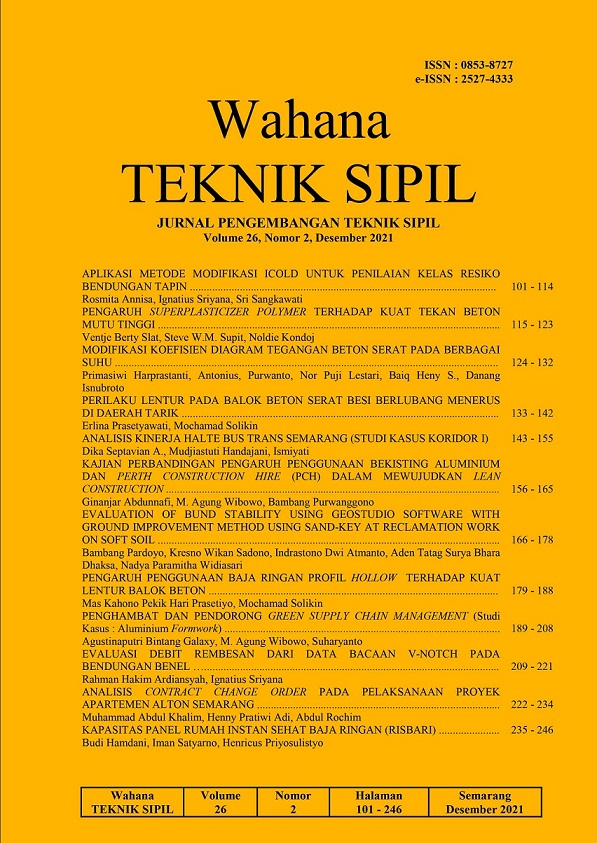MODIFIKASI KOEFISIEN DIAGRAM TEGANGAN BETON SERAT PADA BERBAGAI SUHU
DOI:
https://doi.org/10.32497/wahanats.v26i2.3127Keywords:
fiber, concrete, steel wire, tension diagramAbstract
Fiber concrete is a building material that has been widely introduced in Indonesia. The advantages of fiber concrete are that it can increase the tensile strength of concrete, besides fiber concrete can increase ductility compared to concrete without fibers. In this study, steel wire fibers were used. The weakness of this fiber concrete is against high temperatures. Experiments were carried out with reinforcing fiber concrete at temperatures of 332 °C, 621.4 °C, and 957.4 °C. Fiber concrete that is burned at high temperatures has a significant decrease in strength when it is burned reaching a temperature of 957.4 °C. On the stress curve, fiber concrete that is burned at a temperature of 621.4 °C has a stress drop of up to 67%. The stress-strain behavior of steel-wire fiber concrete is very ductile when compared to fiber-free concrete. In the concrete stress diagram, the ß1 and k3 coefficients in fiberless concrete and fiber concrete are not the same. Based on the calculations carried out, the value of k3 in fiber concrete at various temperatures is taken as 0.92fc”™, while the value of ß1 in fiber concrete at various temperatures is 0.75.References
ACI Commite 544. May 1982, State of The Art Report on Fibre Reinforced Concrete, ACI 544. IR-82, ACI, Detroit, Michigan Antonius, Setiyawan, P., 2006, Kajian besaran mekanis beton berserat mutu tinggi (studi eksperimental), Jurnal Wahana Teknik Sipil, Politeknik Neg. Semarang, Vol. 11(3), 74-81.
Antonius, Widhianto, A., Darmayadi, D., Asfari, G.D., 2014, Fire Resistance of Normal and High Strength Concrete with Contains of Steel Fibre, Asian Journal of Civil Engineering vol.15 no. 5, pages 655-669.
Aslani F., Bastami M., 2011, Constitutive Relationships for Normal and High Strength Concrete at Elevated Temperature, ACI Materials Journal, 355-364.
ASTM C 39 ”“ 94, 1996, Test Methode for Compressive Strength of Cylindrical Concrete Spesimens, Annual Books of ASTM Standards, USA.
Badan Standarisasi Indonesia, SNI 2847-2013, Persyaratan Beton Struktural untuk Bangunan Gedung.
Badan Standarisasi Indonesia, SNI 7656-2012, Tata Cara Pemilihan Campuran Beton Normal, Beton Serat dan Beton Massa.
British Standard, 2004, Design of Concrete Structure. Part 1.2: General Rules-Structural Fire Design, Commission of European Communities, Brussels, Belgium. 100 p.
Dhinakaran, G., Vijayarakhavan, S., Kumar, K.R, 2016, Fracture and Flexural Behavior of High-performance Fiber Reinforced Concrete, Asian Journal of Civil Engineering, Volume 17(1), pp. 1”“14
Iqbal, S.A., Ali, K., Holschemacher, Bier, T.A., 2015, Mechanical Properties of Steel Fiber Reinforced High Strength Lightweight Self-Compacting Concrete (SHLSCC), Construction and Building Materials, Volume 98, pp. 325”“333
Janani, S., Santhi, A.S., 2018, Multiple Linear Regression Model for Mechanical Properties and Impact Resistance of Concrete with Fly Ash and Hooked-end Steel Fibers, International Journal of Technology, Volume 9(3), pp. 526”“536
Jansson, A., Lofgren, I., Lundgren, K., Gyltoft, K., 2012, Bond of Reinforcement in Selfcompacting Steel-fibre-reinforcement Concrete, Magazine of Concrete Research, Volume 64(7), pp. 617”“630
Kodur, V.K.R., Dwaikat M.M.S., Dwaikat MB. 2008, High-Temperature Properties of Concrete for Fire Resistance Modeling of Structure, ACI Materials Journal. 355-364.
Li L, Purkiss JA, 2005, Stress-Strain Constitutive Equations of Concrete Material at Elevated Temperature, Fire Safety Journal, 669-686.
Suhendro, B, 1991, Pengaruh Fiber Kawat Lokal Pada Sifat ”“ sifat Beton, Laporan Penelitian, Lembaga Penelitian UGM, Yogyakarta.
Downloads
Published
Issue
Section
License
Authors who publish with this journal agree to the following terms:Authors retain copyright and grant the journal right of first publication with the work simultaneously licensed under a Creative Commons Attribution License that allows others to share the work with an acknowledgement of the work's authorship and initial publication in this journal.
Authors are able to enter into separate, additional contractual arrangements for the non-exclusive distribution of the journal's published version of the work (e.g., post it to an institutional repository or publish it in a book), with an acknowledgement of its initial publication in this journal.
Authors are permitted and encouraged to post their work online (e.g., in institutional repositories or on their website) prior to and during the submission process, as it can lead to productive exchanges, as well as earlier and greater citation of published work (See The Effect of Open Access).






